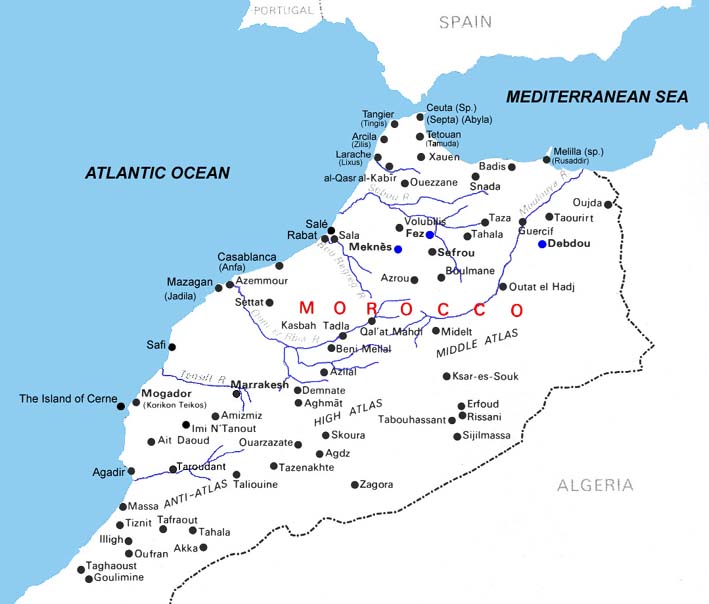
Moroccan History

Muslim Conquest
Morocco experienced a revival under the Saadians, known as the first Sharifian dynasty (1554-1660). The reign (1579-1603) of Ahmed I al-Man-sur is regarded as the golden age of Morocco. The country benefited enormously from the influx of nearly a million Moors and Jews who were expelled from Spain after 1492. It was uniFied and relatively prosperous; its native arts and architecture flourished.
The Saadians were succeeded by the second Sharifian dynasty, who have ruled since 1660. This dynasty reached its peak in the reign of Ismail al-Hasani (reigned 1672-1727). Al-Hasani's reign was followed by a long period of disorder, which was punctuated with brief interludes of relative peace and prosperity.
European Intrusion
In 1415 Portugal had captured the port of Ceuta. This intrusion initiated a period of gradual extension of Portuguese and Spanish power over the Moroccan coastal region. The Moroccans inflicted a severe defeat on the Portuguese in 1578, and by the end of the 17th century they had regained control of most of their coastal cities. In the 18th and early 19th centuries pirates from Morocco and other so-called Barbary states of North Africa preyed on the shipping that plied the Mediterranean Sea (see Barbary Coast). Because of the depredations of the Barbary pirates and because Morocco shared control of the Strait of Gibraltar with Spain, the country figured with increasing weight in the diplomacy of the European maritime powers, particularly Spain, Great Britain, and France. Spain invaded Morocco in 1859-60 and acquired Tétouan.
In April 1904, in return for receiving a free hand in Egypt from France, Great Britain recognized Morocco as a French sphere of interest. Later that year France and Spain divided Morocco into zones of influence, with Spain receiving the much smaller part of a sublessee of France. Imperial Germany soon disputed these arrangements, and a conference of major powers, including the United States, met in Algeciras, Spain, in January 1906, to conclude an agreement. The resultant Act of Algeciras guaranteed equality of economic rights for every nation in Morocco.
In July 1911, the Germans sent a gunboat to the Moroccan port city of Agadir, in a move designed to encourage native resistance to French dominance. This incident provoked French mobilization and brought Europe to the brink of war, but in later negotiations Germany agreed to a French protectorate over Morocco in return for French territorial concessions elsewhere in Africa.
In March 1912 the Sultan recognized the protectorate. Later that year the French, under a revision of the 1904 convention with Spain, obtained a larger share of Moroccan territory.
Fight for Independence
The Spanish experienced even greater difficulties in Spanish Morocco. Abd-el-Krim, a leader of Rif tribes, organized a revolt against Spanish rule in 1920. By 1924 he had driven the Spanish forces from most of their Moroccan territory. He then turned upon the French. France and Spain agreed in 1925 to cooperate against Abd-el-Krim. More than 200,000 troops under the French marshal Henri Philippe Pétain were used in the campaign, which ended victoriously in 1926. The country was not fully paciFied, however, until the end of 1934.
Following Germany's defeat of France in 1940, France's collaborationist Vichy government allowed Morocco to support the German war effort. In November 1942, American troops landed and occupied Morocco. During the rest of World War II, the country was a major Allied supply base. Casablanca was the site of a meeting of the heads of government of the Allies in 1943.
In 1944, Moroccan nationalists formed the Istiqlal party, which soon won the support of Sultan Muhammed V and the majority of Arabs. It was opposed by most of the Berber tribes, however. The French rejected the plea by the Sultan in 1950 for self-government. The Sultan was deposed in August 1953, but in October 1955 the French permitted him to return to his throne.
See
Virtual
Jerusalem for information about jews of Morocco.
Daniel E. LOEB, eMail: loeb17@gmail.com


